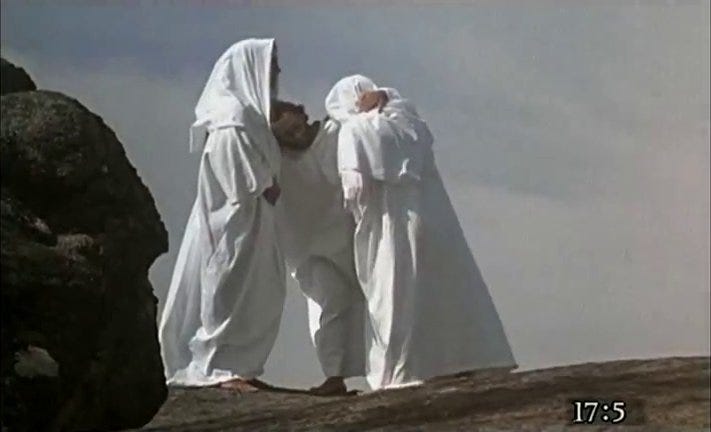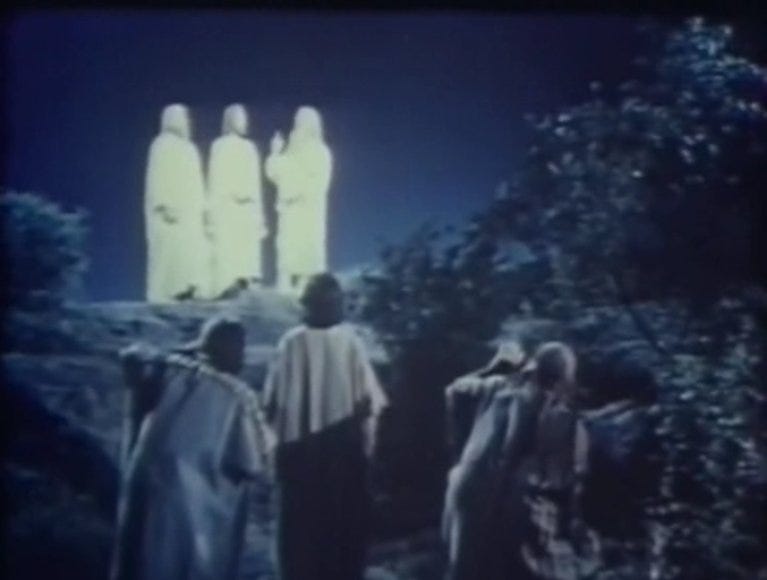The Transfiguration – six cinematic treatments
The Transfiguration has never been depicted in a conventional dramatic Jesus movie that I know of. But here are half a dozen films that *have* depicted it.
Today is the Feast of the Transfiguration, which commemorates the time when Jesus took three of his closest disciples up a mountain and spoke to Moses and Elijah while his face and his clothes shone brightly, like lightning or sunlight (Mark 9:2-13, Matthew 17:1-13, Luke 9:28-36). This story has not been adapted in film very often, so I figured I’d do a quick round-up of some of the films that have depicted it.
First, and most obviously, there are the word-for-word adaptations of the gospels, which have to depict the Transfiguration simply because it’s there in the text. There have been three such adaptations so far: the Genesis Project’s adaptation of Luke from the 1970s, the Visual Bible’s adaptation of Matthew from the 1990s, and the Lumo Project’s adaptation of all four gospels from the 2010s. (The Visual Bible also adapted John in 2003, but the Transfiguration isn’t mentioned in that gospel.)
This is how the Transfiguration appears—with Moses and Elijah looking kind of ghostly or ethereal—in Jesus (dir. Peter Sykes & John Krish, 1979), the feature film that was extracted from the Genesis Project’s The Gospel According to St. Luke (1979):
And this is how the Transfiguration appears in the Visual Bible’s The Gospel According to Matthew (dir. Reghardt van den Bergh, 1993)—which, in keeping with the emotionalist tenor of that film, has Jesus physically leaning on Moses and Elijah for support as he is apparently overwhelmed by the prospect of his death:
Incidentally, while all three gospels that mention the Transfiguration say that Jesus was talking to Moses and Elijah, the gospels of Matthew and Mark don’t say what Jesus was talking to them about. It is only Luke’s gospel which tells us that Jesus spoke to Moses and Elijah “about his departure, which he was about to bring to fulfillment at Jerusalem.” So if the Visual Bible’s adaptation of Matthew shows Jesus leaning on Moses and Elijah as a foreshadowing of the intense emotions he will feel at his arrest and crucifixion, one could argue that the Visual Bible is not just giving us an adaptation of Matthew’s gospel but is synthesizing two different gospel accounts.
(All that being said, Mark and Matthew both say that Jesus told the three disciples who accompanied him not to tell anyone what they saw until after the Son of Man had risen from the dead, and Mark’s gospel says the disciples wondered what “rising from the dead” could mean. So there’s a foreshadowing of Jesus’ death in that, too.)
The Lumo Project is the only series that has adapted two or more of the gospels that describe the Transfiguration—but it uses the same footage in all three films, The Gospel of Mark, The Gospel of Luke, and The Gospel of Matthew (dir. David Batty, 2015-2016). I used a shot from those films at the top of this post, so here’s a wider shot that shows the disciples just before they notice the appearance of Moses and Elijah:
Prior to these films, you pretty much have to go all the way back to the silent era—when there was less emphasis on naturalistic drama and more on visual iconography—to find more-commercial films that have depicted this episode from Jesus’ life.
A prime example of this is The Life and Death of Jesus Christ (dir. Ferdinand Zecca & Lucien Nonguet, 1902-1905), which doesn’t bother to hide its stagecraft:
Christus (dir. Giulio Antamoro, 1916) tends to use more naturalistic outdoor settings, but a title card tells us this scene is inspired by a Raphael painting, and what’s striking about this film’s Transfiguration scene is how, like the painting, it combines the Transfiguration with the next story in the gospels, about a demon-possessed boy that Jesus’ other disciples failed to exorcise while Jesus was up on the mountain (Mark 9:14-29, Matthew 17:14-21, Luke 9:37-43). The setting may be more naturalistic, but the juxtaposition of Jesus standing serenely at the top of the hill while all the commotion is taking place just a few feet away at the bottom is, itself, more iconographic:
Aside from the word-for-word adaptations and the more commercial silent films, there are also the short films that have been produced as educational tools for Sunday schools and the like. For example, my friend Matt Page notes that there is a Transfiguration scene in Episode 10 of The Living Christ, a 12-part series from 1951:
And that … just might be it.
There may be other films that have depicted the Transfiguration, but those are the only ones I know about. I just went through the scripture and topical indices in four different books on Jesus movies and Bible movies in general, and none of them—not one—had an entry for the Transfiguration, or for any of the three passages in the gospels that talk about it. It would appear that this scene has been filmed so rarely that the people who write about Jesus films almost never even talk about it.
But the Transfiguration is kind of a big deal, theologically—it appears in three of the four canonical gospels and it’s one of the Twelve Great Feasts in Eastern Orthodoxy, and it is commemorated today by Catholics, Anglicans, and others as well. So it would be nice if some filmmakers tried to weave it into the story of Jesus dramatically, with some awareness of what it said about the character of Jesus or his disciples.
As it is, it seems like filmmakers generally tackle the subject only when they’re working in a purely iconographic mode, or when they’re sticking strictly to the exact text of the gospels. Here’s hoping someone gets a little more adventurous.
-
Side note: It would greatly amuse me if Christian Bale ever played Elijah some day, because he has already played both Jesus (in 1999’s Mary, Mother of Jesus) and Moses (in 2014’s Exodus: Gods & Kings), so if he ever played Elijah too, someone could do a makeshift Transfiguration mash-up using footage from all three films.









